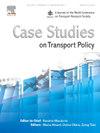Redesign of public transit in low-demand areas, and integration with shared modes, based on travel preferences: A case study analysis in the province of Utrecht, the Netherlands
IF 3.3
Q3 TRANSPORTATION
引用次数: 0
Abstract
Offering shared mobility options at transit stops can potentially increase the service area of a stop and consequently, possible detours in transit lines can be eliminated to decrease in-vehicle travel times for through-passengers and reduce operational costs. However, current research mostly focusses on shared mobility options and expected behaviour only, whilst not looking at this integrated transit network design problem. Additionally, most focus of current studies is on the integration of shared mobility in urban areas and/or around train stations, leaving a gap on suburban areas and transit lines with lower demand.
In order to answer our research question “what the effects are of increased route directness for low-demand transit lines in conjunction with offering shared mobility at transit stops”, we developed a mesoscopic model extension for the aggregated four-step transport model to model changes in travel behaviour as a result of straightened transit lines and the simultaneous integration of shared modes. Discrete choice models are used to accurately model first and last mile preferences of people, based on the access and egress distance, demographics and available (shared) modes. Finally, the probability of passengers cancelling their complete trip as a result of increased first and last mile distances is also explored.
This model framework was applied to nine case studies in the Netherlands. The synthesis of the case studies resulted in key factors contributing to a promising redesign of the transit network. The main factor is that through-passengers should significantly outnumber local passengers, by at least 75%-25%. Additionally, the increase in access and egress times should not be significantly larger than in-vehicle time savings of through-passengers. Moreover, it is found that the mode share of micromobility in the first and last mile is approximately 15% across the different cases, whereby the highest usage can be seen for people under the age of 25 and for distances greater than 1 km. Finally, it is concluded that the additional costs of shared mobility are on average only 10% of the savings in operational costs.
在低需求地区重新设计公共交通,并基于出行偏好整合共享模式:以荷兰乌得勒支省为例分析
在公交站点提供共享出行选项可以潜在地增加站点的服务面积,因此可以消除公交线路上可能的弯路,从而减少过境乘客的车内旅行时间并降低运营成本。然而,目前的研究主要集中在共享交通选择和预期行为上,而没有关注这种综合交通网络设计问题。此外,目前的研究大多集中在城市地区和/或火车站周围的共享交通的整合上,而在需求较低的郊区和公交线路上留下了空白。为了回答我们的研究问题“在公交站点提供共享交通的同时增加低需求公交线路的路线直接性会产生什么影响”,我们为汇总的四步运输模型开发了一个介观模型扩展,以模拟由于公交线路变直和共享模式同时整合而导致的出行行为变化。离散选择模型用于根据进出距离、人口统计和可用(共享)模式,准确地模拟人们的第一英里和最后一英里偏好。最后,还探讨了由于第一英里和最后一英里距离增加而导致乘客取消整个行程的概率。该模型框架应用于荷兰的9个案例研究。综合案例研究得出了有助于重新设计交通网络的关键因素。主要的因素是直航旅客的数量应该明显超过本地旅客,至少要高出75%-25%。此外,进出时间的增加不应显著大于直通车乘客在车内节省的时间。此外,研究发现,在不同的情况下,第一英里和最后一英里的微移动模式份额约为15%,其中25岁以下的人群和距离大于1公里的人群的使用率最高。最后得出的结论是,共享出行的额外成本平均仅为节省的运营成本的10%。
本文章由计算机程序翻译,如有差异,请以英文原文为准。
求助全文
约1分钟内获得全文
求助全文

 求助内容:
求助内容: 应助结果提醒方式:
应助结果提醒方式:


